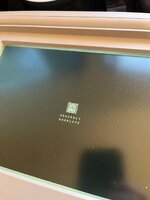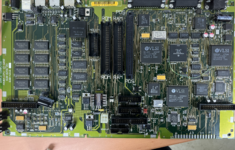Yep, I‘ve tried it in both connectors. I‘ll check the INDISK-signal at home, but also an external drive doesn‘t do anything.
Ah, you tried an external drive. Perfect. Yeah, then INDISK is rather unlikely, since for an external drive it isn't multiplexed, but ENBL2 goes (basically) directly to the external floppy port. If that also doesn't work, then there is something else going on. Thinking about it "INDISK" likely means internal disk - somehow my head always want to interpret it as "inserted disk"

In addition, you said the device spins up, so INDISK should be fine anyways, because the drive spins up, so it must get enabled

If I remember correctly, accessing floppy drives works somewhat like this:
At first, the firmware uses the VIA to tell the PMGR to pull the IWM_CNTRL signal high. The CPU GLU then reacts by enabling the ISM_CLK clock signal for the SWIM. The portable is special in that regard, since the clock signal is only enabled when the SWIM is actually being used - likely in an effort to further reduce power consumption. (In the beginning, I actually believed that to be a bug, since on other Macs its present all the time - until I stumbled across IWM_CNTRL

)
Then, the software uses the SWIM and starts "scanning" the drives by enabling the drives one after another. In order to use the one external and two internal drives, the MISC GLUE is used to multiplex the SWIM's first enable ENABL1 signal to both internal drive ports. So from the perspective of the SWIM, the first drive gets scanned multiple times while the enable signal is redirected to the respective internal drive. (Funny side note: That also means that if you short both INDISK signals together while having a single internal drive, it will appear twice...

)
Finally, in order to communicate with a drive, the SWIM uses the PHASE0-3 signals, the RDDATA signal to read serial data from the disk and the SENSE signal to read device status information. For machines with Sony disk drives, the RDDATA and SENSE signals are meant to be tied together according to the SWIM documentation. The portable calls this combined signal SWIM_RD.
(In context of the ISM, the ISM-specific documentation mentions that the SENSE signal is used explicitly for write protection detection. All documentations can be found here [1].)
Unfortunately, I'm not exactly sure how the SWIM handles disk detection, because the documentation doesn't expand on that, but I would bet that RDDATA and SENSE are primarily involved there. The issue with the SWIM is that it is a combination the old IWM and the new ISM chips.
If the SWIM is in IWM-mode, the PHASE signals appear to be outputs only, so the RDDATA/SENSE signals should be the corresponding inputs. In ISM mode, however, the PHASE signals can be configured as both inputs and outputs. Still, I would assume that the SWIM is going to be in IWM-mode during boot, since that's the default for all legacy hardware.
As the (a) portable is able to boot at all, (b) manages to complete POST, (c) all drives are affected and (d) the drive spins up, then I would initially assume that the SWIM is good, since it can still communicate with the rest of the machine and also the drives, but the SWIM_RD signal is somehow not received by the SWIM. There might be a broken/compromised trace on the path of that signal.
It is even possible that the 74AC244 bus driver which drives the RD signal from the floppy connectors to the SWIM_RD signal could be affected.
(It is likely not completely broken, since it is also involved in driving the EN245B signal that is also heavily involved in controlling the interface of the RAM to the address bus. I think I had a compromised 74AC244 once before, but I'm not sure anymore... The memories are quite overlapping

)
If the all traces and the 74AC244 are good, then I'd assume that the SWIM is really bad after all. Then you are quite "lucky" blown PMGR and SWIM on the same portable :-|
Sorry, if the post is a bit lengthy, but I thought I write it down for once before I start forgetting some of details again..

[1]
https://archive.org/details/SWIMDesignDocs




